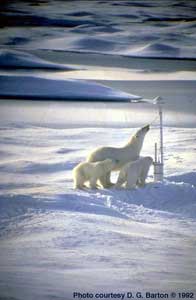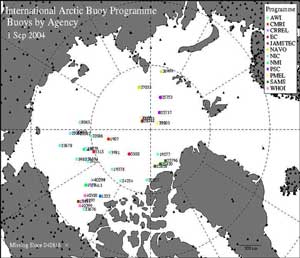
Monitoring the Arctic Ocean: The International Arctic Buoy Program
ENS Bryan Wagonseller, NOAA and LT Magda Hanna, USN, National Ice Center, Washington, DC
|
Because the arctic buoys are such an out-of-the-ordinary
sight on the Arctic Ocean, their presence draws the attention of these curious polar bears. |
Characterized by its unrelenting cold weather and partially frozen surface, the Arctic Ocean is one of the world's smallest oceans and one of the most dynamic in terms of climate. In order to understand more about the oceanic processes and properties that prevail in the Arctic Ocean, the International Arctic Buoy Program (IABP) has made it an objective to establish and maintain a network of data buoys drifting on the sea ice of the Arctic Ocean. The purpose of these data buoys is to provide meteorological and oceanographic data for real-time operational requirements and research purposes (http://iabp.apl.washington.edu/Principles.htm).
The IABP is a collaborative effort by domestic and international research agencies and organizations to monitor sea level pressure, surface air temperature, ice motion, and other geophysical variables. The United States' contribution to the IABP is coordinated through the United States Interagency Arctic Buoy Program (USIABP), which is managed by the National Ice Center (NIC). The USIABP is also a collaborative effort, drawing operating funds and services from a number of government organizations and research programs within the U.S. Among them are the International Arctic Research Center at the University of Alaska Fairbanks, the National Aeronautics and Space Administration, the NIC, the National Oceanic and Atmospheric Administration (NOAA), the National Science Foundation, the Naval Oceanographic Office, the Naval Research Laboratory, the Office of Naval Research, and the U.S. Coast Guard.
Since 1979, an average of 25 buoys per year have been deployed at different locations in the Arctic Ocean. By tracking each buoy, data can be retrieved about the buoy's movement and how the pressure and temperature changes over time. This network of buoys allows one to get the bigger picture of Arctic climate conditions throughout the year, which is valuable for forecasting Arctic weather and climate research. The position and data from the buoys are collected through the Argos Data Collection System, incorporated into the NOAA Polar-orbiting Operational Environmental Satellites (POES) system (http://noaasis.noaa.gov/ARGOS).

|
The arctic buoys are represented as color-coded
dots corresponding to their respective contributors |
The funding for the network of buoys comes from a variety of sources, all of which have interests in the study of Arctic climatology. About 25 to 30 buoy deployments are needed per year to maintain the network at its current number. The USIABP contributes an average of 10 buoy deployments per year. The international community, represented by 7 other countries, contributes the funds to produce the rest of the buoys. The buoys are deployed by such platforms as icebreakers and U.S. Navy P-3 aircraft, making the logistics of transportation relatively easy to manage. Once the buoys are deployed, they begin work by transmitting the data they collect at their respective locations. Each buoy has a life span of approximately 2 years. However, the buoys are susceptible to sinking in the event of ice melting, which makes the yearly replenishment vital to the health of the network.
The success of the IABP is evident by the number of publications produced as a result of the observations made by the buoys. (http://iabp.apl.washington.edu/Citations) The IABP is coordinated by Ignatius Rigor at the Polar Science Center, a division of the Applied Physics Laboratory at the University of Washington and LT Magda Hanna at the NIC manages the USIABP.
The NIC is a unique national asset and a successful model of a Joint Interagency Command consisting of the U.S. Navy, NOAA, and U.S. Coast Guard personnel. The NIC's mission is to provide global, regional and tactical scale sea ice analyses and forecasts for a variety of customers. Please visit the National Ice Center web page for more information or contact the NIC Liaison Officer, ENS Bryan Wagonseller at liaison@natice.noaa.gov or (301) 394-3100.
Contributor Biographies:
ENS Bryan Wagonseller is Liaison Officer of the National/Naval Ice Center in Washington, DC. He is an active duty member of the NOAA Commissioned Corps. His previous assignment with the NOAA Corps included serving as Operations Officer aboard the NOAA Ship DELAWARE II, Woods Hole, MA.
LT Magda Hanna is Transitions Officer for the Science and Applied Technology Department of the National/Naval Ice Center in Washington, DC. She is an active duty member of the United States Navy. Her previous assignment with the U.S. Navy included serving as Electrical Officer and Assistant Navigator aboard the USS HIGGINS (DDG 76), San Diego, CA.
Page last modified: